HRM Problem Solving and Decision Making: Wesfarmers Case Study
VerifiedAdded on 2022/12/27
|26
|5047
|5
Report
AI Summary
This report provides an in-depth analysis of HRM problem-solving techniques within the context of the organization Wesfarmers. It begins with an executive summary outlining the study's objectives, which are to determine the impact of problem-solving techniques on the organization. The report addresses various HR-related challenges faced by Wesfarmers, including recruitment, retention, productivity, health and safety, workforce diversity, payroll, and the effects of globalization. It then explores the integration of problem-solving techniques, detailing the problem-solving process and the decision-making process, including identification of the problem, gathering information, identifying alternatives, evaluating alternatives, choosing alternatives, implementation and evaluation. Furthermore, the report delves into decision-making models, differentiating between classical and behavioral models, and explores the personal decision framework, including directive, analytical, conceptual, and behavioral styles. The report concludes by emphasizing the importance of problem-solving and decision-making processes in organizations to understand the viewpoints of individuals and groups, and to address HR problems effectively.
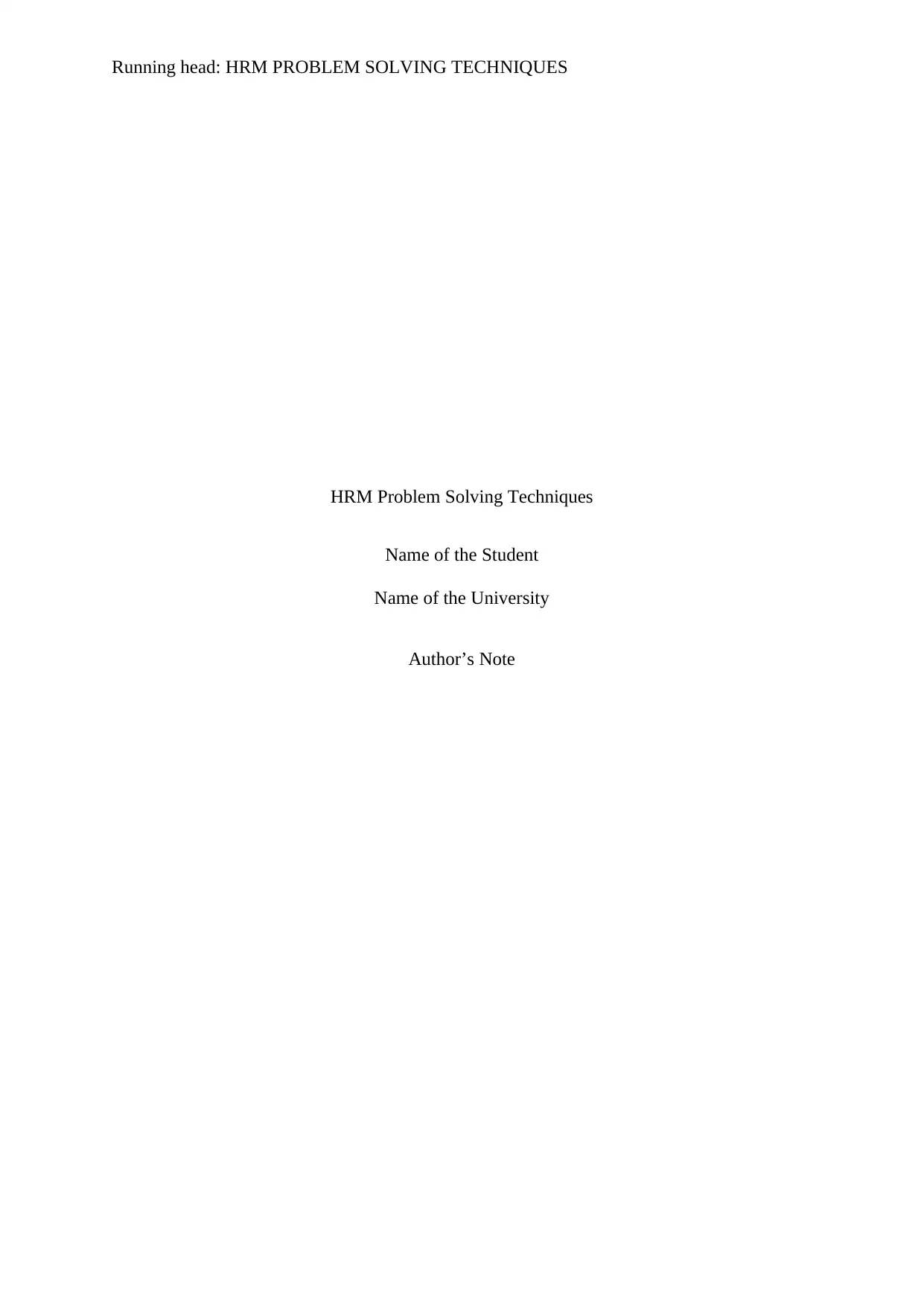
Running head: HRM PROBLEM SOLVING TECHNIQUES
HRM Problem Solving Techniques
Name of the Student
Name of the University
Author’s Note
HRM Problem Solving Techniques
Name of the Student
Name of the University
Author’s Note
Paraphrase This Document
Need a fresh take? Get an instant paraphrase of this document with our AI Paraphraser
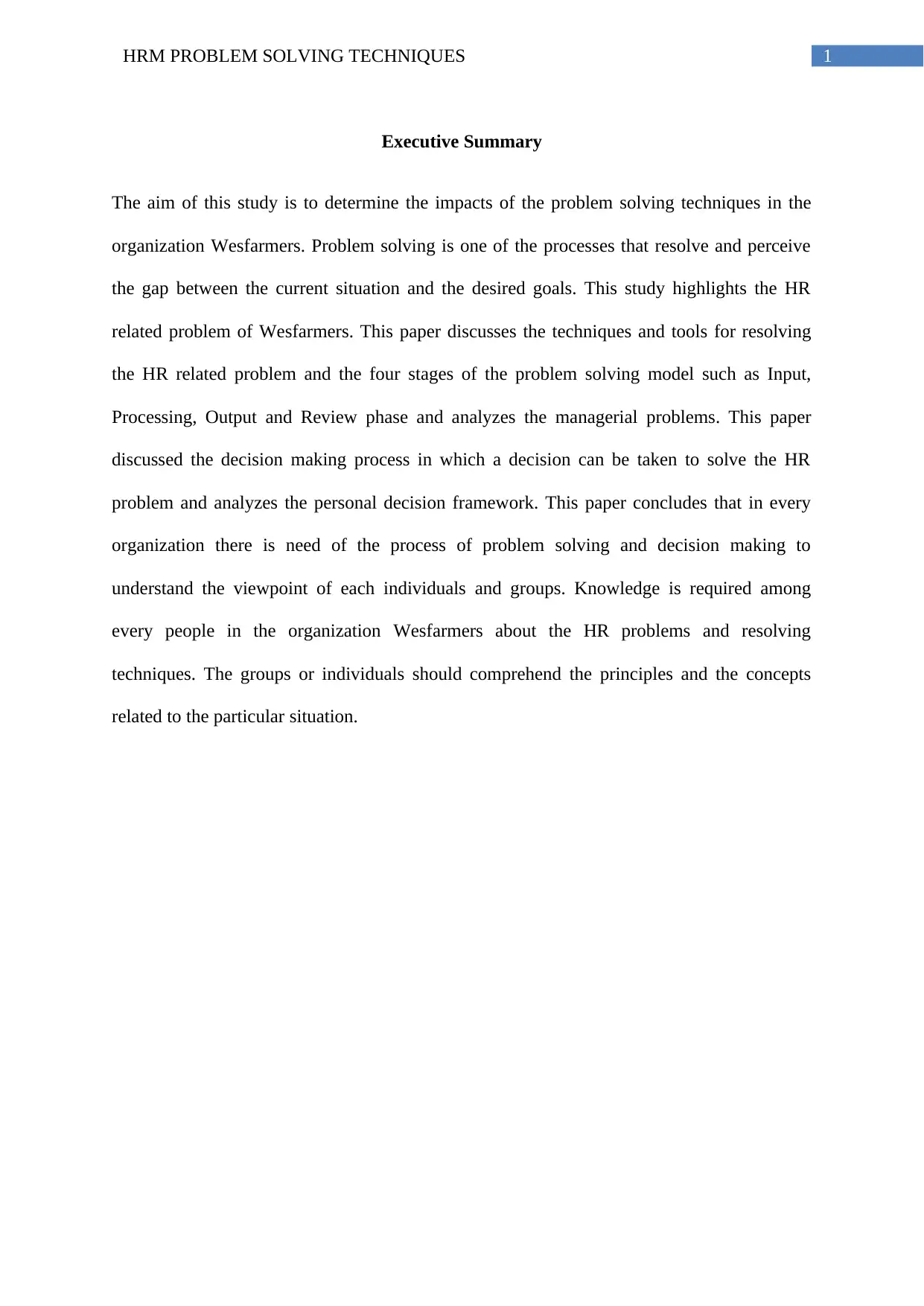
1HRM PROBLEM SOLVING TECHNIQUES
Executive Summary
The aim of this study is to determine the impacts of the problem solving techniques in the
organization Wesfarmers. Problem solving is one of the processes that resolve and perceive
the gap between the current situation and the desired goals. This study highlights the HR
related problem of Wesfarmers. This paper discusses the techniques and tools for resolving
the HR related problem and the four stages of the problem solving model such as Input,
Processing, Output and Review phase and analyzes the managerial problems. This paper
discussed the decision making process in which a decision can be taken to solve the HR
problem and analyzes the personal decision framework. This paper concludes that in every
organization there is need of the process of problem solving and decision making to
understand the viewpoint of each individuals and groups. Knowledge is required among
every people in the organization Wesfarmers about the HR problems and resolving
techniques. The groups or individuals should comprehend the principles and the concepts
related to the particular situation.
Executive Summary
The aim of this study is to determine the impacts of the problem solving techniques in the
organization Wesfarmers. Problem solving is one of the processes that resolve and perceive
the gap between the current situation and the desired goals. This study highlights the HR
related problem of Wesfarmers. This paper discusses the techniques and tools for resolving
the HR related problem and the four stages of the problem solving model such as Input,
Processing, Output and Review phase and analyzes the managerial problems. This paper
discussed the decision making process in which a decision can be taken to solve the HR
problem and analyzes the personal decision framework. This paper concludes that in every
organization there is need of the process of problem solving and decision making to
understand the viewpoint of each individuals and groups. Knowledge is required among
every people in the organization Wesfarmers about the HR problems and resolving
techniques. The groups or individuals should comprehend the principles and the concepts
related to the particular situation.
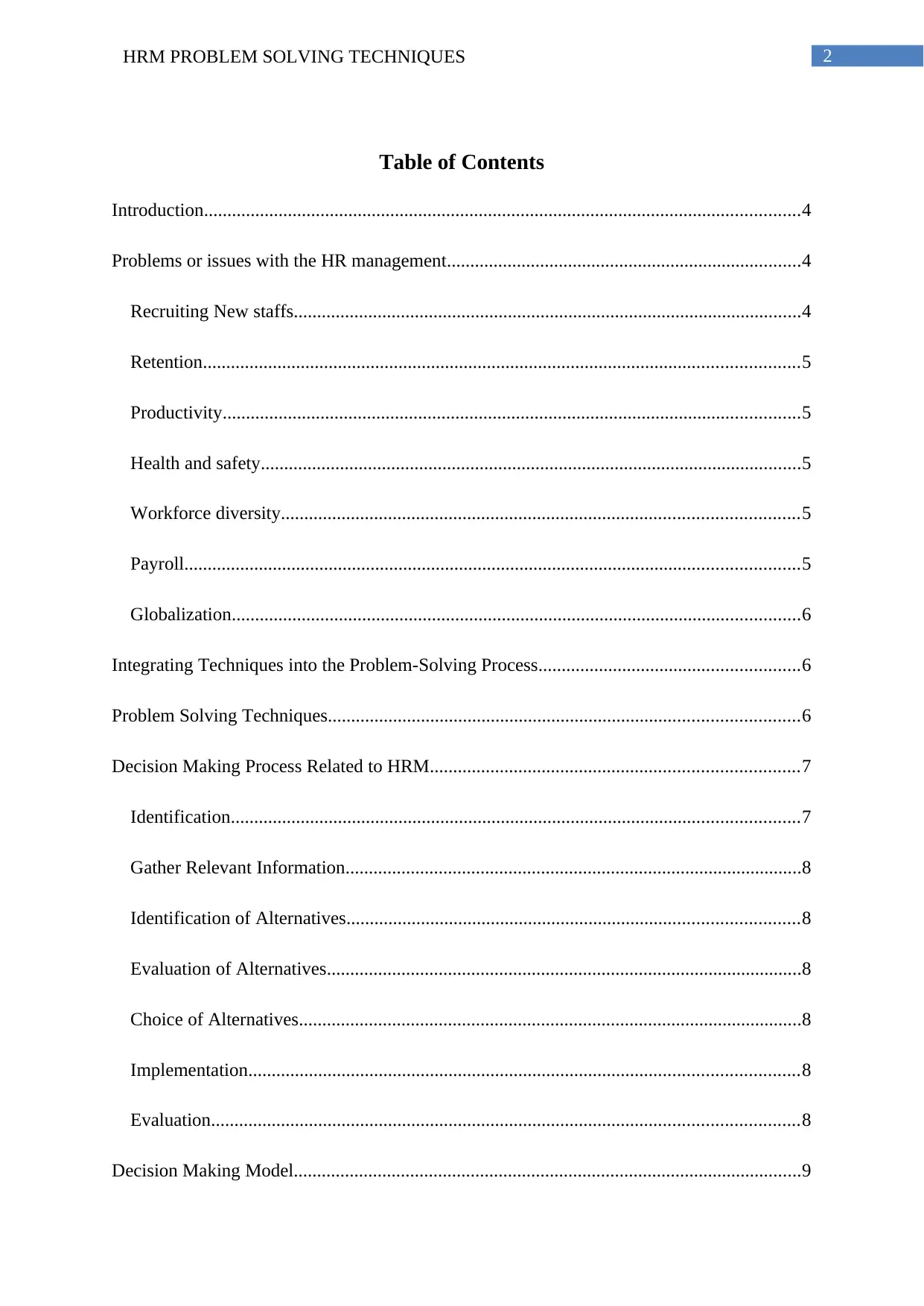
2HRM PROBLEM SOLVING TECHNIQUES
Table of Contents
Introduction................................................................................................................................4
Problems or issues with the HR management............................................................................4
Recruiting New staffs.............................................................................................................4
Retention................................................................................................................................5
Productivity............................................................................................................................5
Health and safety....................................................................................................................5
Workforce diversity...............................................................................................................5
Payroll....................................................................................................................................5
Globalization..........................................................................................................................6
Integrating Techniques into the Problem-Solving Process........................................................6
Problem Solving Techniques.....................................................................................................6
Decision Making Process Related to HRM...............................................................................7
Identification..........................................................................................................................7
Gather Relevant Information..................................................................................................8
Identification of Alternatives.................................................................................................8
Evaluation of Alternatives......................................................................................................8
Choice of Alternatives............................................................................................................8
Implementation......................................................................................................................8
Evaluation..............................................................................................................................8
Decision Making Model.............................................................................................................9
Table of Contents
Introduction................................................................................................................................4
Problems or issues with the HR management............................................................................4
Recruiting New staffs.............................................................................................................4
Retention................................................................................................................................5
Productivity............................................................................................................................5
Health and safety....................................................................................................................5
Workforce diversity...............................................................................................................5
Payroll....................................................................................................................................5
Globalization..........................................................................................................................6
Integrating Techniques into the Problem-Solving Process........................................................6
Problem Solving Techniques.....................................................................................................6
Decision Making Process Related to HRM...............................................................................7
Identification..........................................................................................................................7
Gather Relevant Information..................................................................................................8
Identification of Alternatives.................................................................................................8
Evaluation of Alternatives......................................................................................................8
Choice of Alternatives............................................................................................................8
Implementation......................................................................................................................8
Evaluation..............................................................................................................................8
Decision Making Model.............................................................................................................9
⊘ This is a preview!⊘
Do you want full access?
Subscribe today to unlock all pages.

Trusted by 1+ million students worldwide
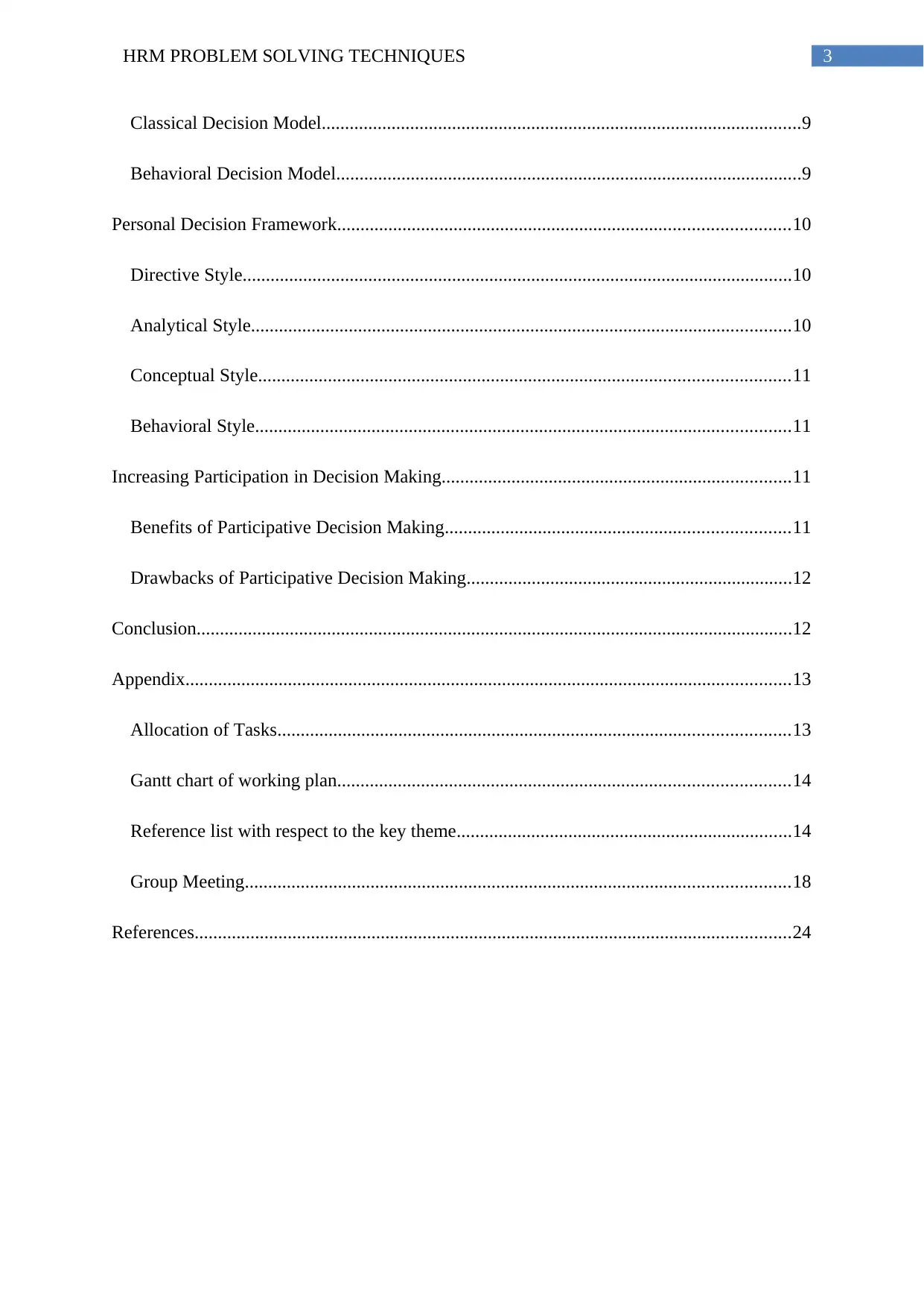
3HRM PROBLEM SOLVING TECHNIQUES
Classical Decision Model.......................................................................................................9
Behavioral Decision Model....................................................................................................9
Personal Decision Framework.................................................................................................10
Directive Style......................................................................................................................10
Analytical Style....................................................................................................................10
Conceptual Style..................................................................................................................11
Behavioral Style...................................................................................................................11
Increasing Participation in Decision Making...........................................................................11
Benefits of Participative Decision Making..........................................................................11
Drawbacks of Participative Decision Making......................................................................12
Conclusion................................................................................................................................12
Appendix..................................................................................................................................13
Allocation of Tasks..............................................................................................................13
Gantt chart of working plan.................................................................................................14
Reference list with respect to the key theme........................................................................14
Group Meeting.....................................................................................................................18
References................................................................................................................................24
Classical Decision Model.......................................................................................................9
Behavioral Decision Model....................................................................................................9
Personal Decision Framework.................................................................................................10
Directive Style......................................................................................................................10
Analytical Style....................................................................................................................10
Conceptual Style..................................................................................................................11
Behavioral Style...................................................................................................................11
Increasing Participation in Decision Making...........................................................................11
Benefits of Participative Decision Making..........................................................................11
Drawbacks of Participative Decision Making......................................................................12
Conclusion................................................................................................................................12
Appendix..................................................................................................................................13
Allocation of Tasks..............................................................................................................13
Gantt chart of working plan.................................................................................................14
Reference list with respect to the key theme........................................................................14
Group Meeting.....................................................................................................................18
References................................................................................................................................24
Paraphrase This Document
Need a fresh take? Get an instant paraphrase of this document with our AI Paraphraser
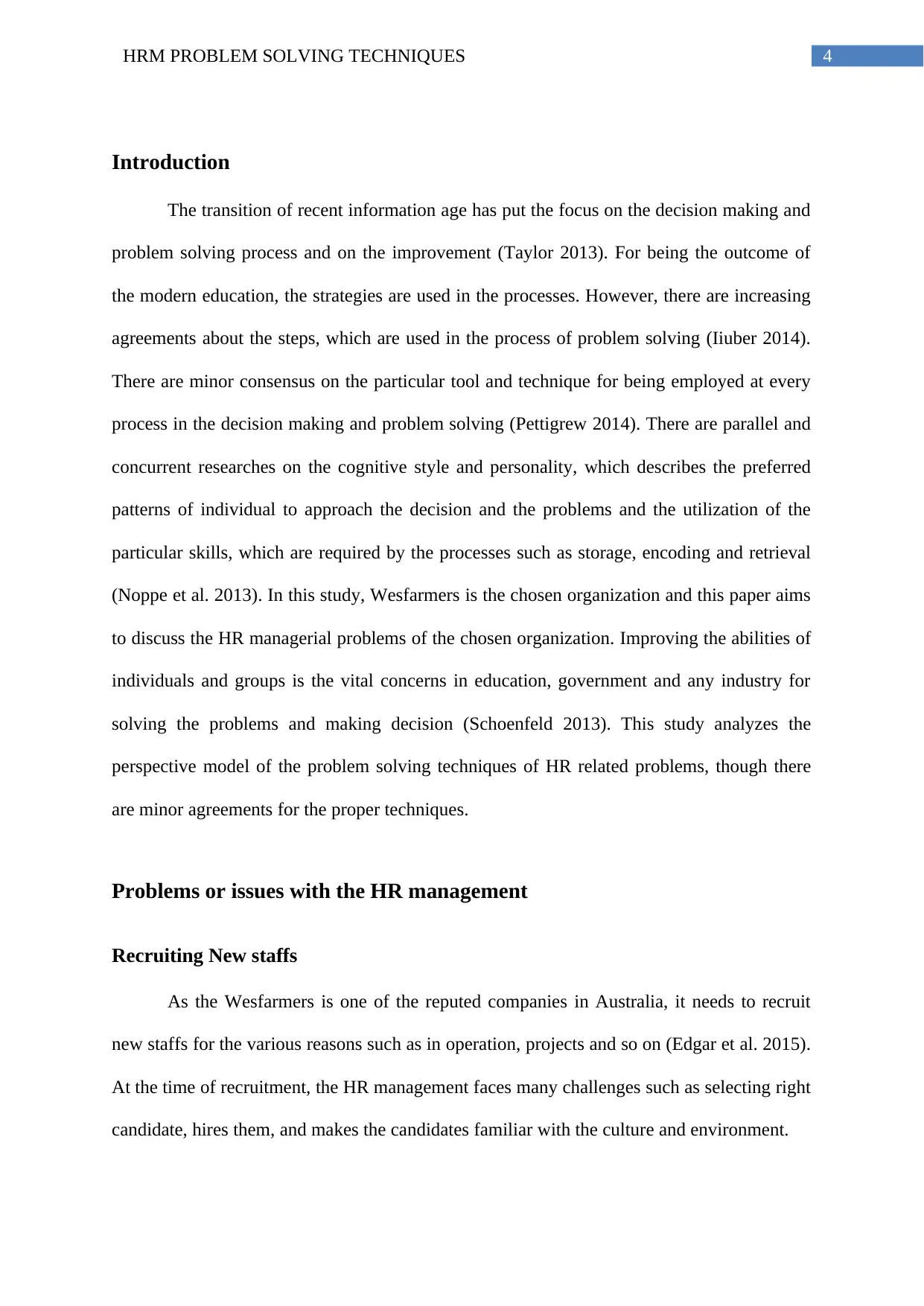
4HRM PROBLEM SOLVING TECHNIQUES
Introduction
The transition of recent information age has put the focus on the decision making and
problem solving process and on the improvement (Taylor 2013). For being the outcome of
the modern education, the strategies are used in the processes. However, there are increasing
agreements about the steps, which are used in the process of problem solving (Iiuber 2014).
There are minor consensus on the particular tool and technique for being employed at every
process in the decision making and problem solving (Pettigrew 2014). There are parallel and
concurrent researches on the cognitive style and personality, which describes the preferred
patterns of individual to approach the decision and the problems and the utilization of the
particular skills, which are required by the processes such as storage, encoding and retrieval
(Noppe et al. 2013). In this study, Wesfarmers is the chosen organization and this paper aims
to discuss the HR managerial problems of the chosen organization. Improving the abilities of
individuals and groups is the vital concerns in education, government and any industry for
solving the problems and making decision (Schoenfeld 2013). This study analyzes the
perspective model of the problem solving techniques of HR related problems, though there
are minor agreements for the proper techniques.
Problems or issues with the HR management
Recruiting New staffs
As the Wesfarmers is one of the reputed companies in Australia, it needs to recruit
new staffs for the various reasons such as in operation, projects and so on (Edgar et al. 2015).
At the time of recruitment, the HR management faces many challenges such as selecting right
candidate, hires them, and makes the candidates familiar with the culture and environment.
Introduction
The transition of recent information age has put the focus on the decision making and
problem solving process and on the improvement (Taylor 2013). For being the outcome of
the modern education, the strategies are used in the processes. However, there are increasing
agreements about the steps, which are used in the process of problem solving (Iiuber 2014).
There are minor consensus on the particular tool and technique for being employed at every
process in the decision making and problem solving (Pettigrew 2014). There are parallel and
concurrent researches on the cognitive style and personality, which describes the preferred
patterns of individual to approach the decision and the problems and the utilization of the
particular skills, which are required by the processes such as storage, encoding and retrieval
(Noppe et al. 2013). In this study, Wesfarmers is the chosen organization and this paper aims
to discuss the HR managerial problems of the chosen organization. Improving the abilities of
individuals and groups is the vital concerns in education, government and any industry for
solving the problems and making decision (Schoenfeld 2013). This study analyzes the
perspective model of the problem solving techniques of HR related problems, though there
are minor agreements for the proper techniques.
Problems or issues with the HR management
Recruiting New staffs
As the Wesfarmers is one of the reputed companies in Australia, it needs to recruit
new staffs for the various reasons such as in operation, projects and so on (Edgar et al. 2015).
At the time of recruitment, the HR management faces many challenges such as selecting right
candidate, hires them, and makes the candidates familiar with the culture and environment.
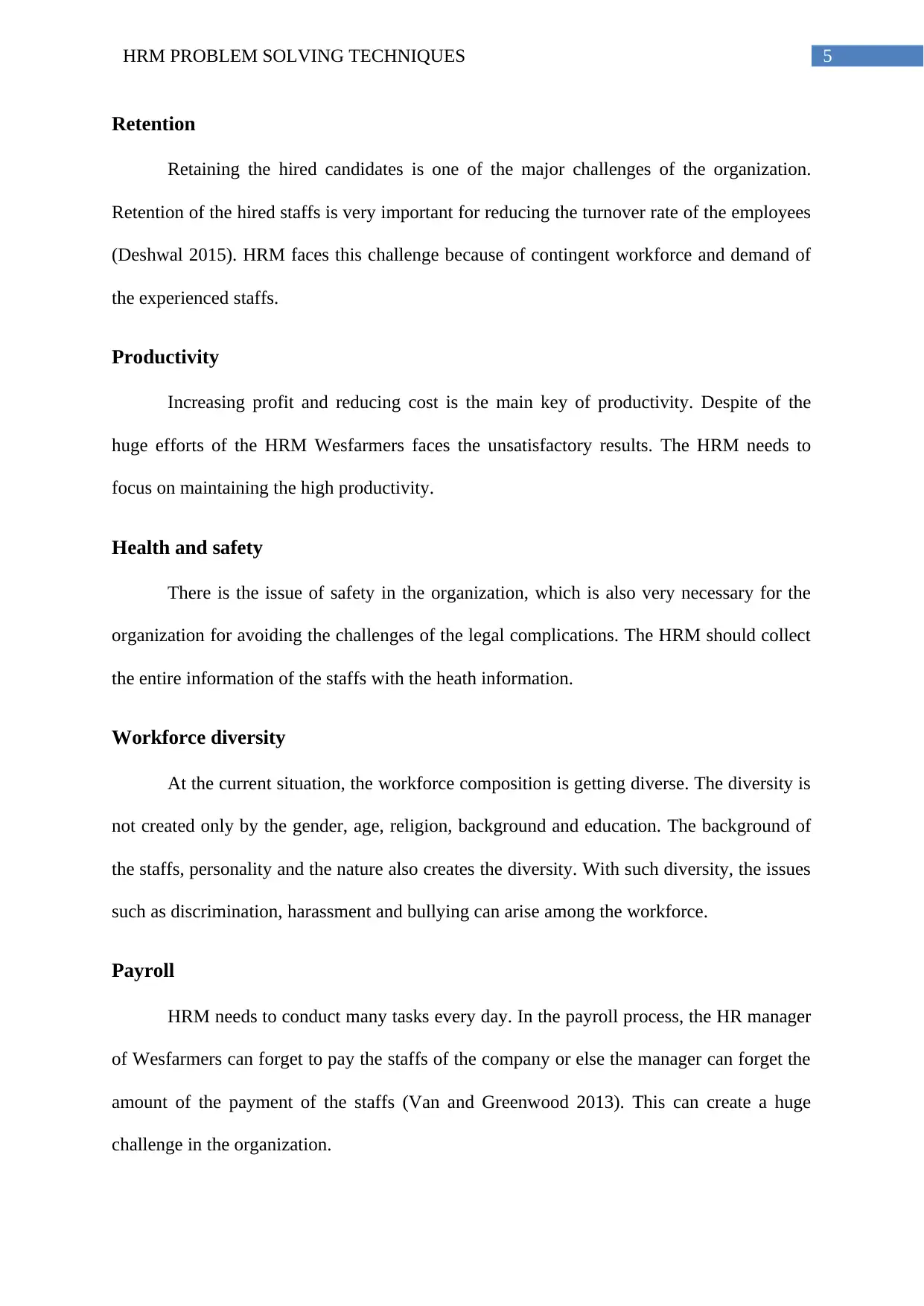
5HRM PROBLEM SOLVING TECHNIQUES
Retention
Retaining the hired candidates is one of the major challenges of the organization.
Retention of the hired staffs is very important for reducing the turnover rate of the employees
(Deshwal 2015). HRM faces this challenge because of contingent workforce and demand of
the experienced staffs.
Productivity
Increasing profit and reducing cost is the main key of productivity. Despite of the
huge efforts of the HRM Wesfarmers faces the unsatisfactory results. The HRM needs to
focus on maintaining the high productivity.
Health and safety
There is the issue of safety in the organization, which is also very necessary for the
organization for avoiding the challenges of the legal complications. The HRM should collect
the entire information of the staffs with the heath information.
Workforce diversity
At the current situation, the workforce composition is getting diverse. The diversity is
not created only by the gender, age, religion, background and education. The background of
the staffs, personality and the nature also creates the diversity. With such diversity, the issues
such as discrimination, harassment and bullying can arise among the workforce.
Payroll
HRM needs to conduct many tasks every day. In the payroll process, the HR manager
of Wesfarmers can forget to pay the staffs of the company or else the manager can forget the
amount of the payment of the staffs (Van and Greenwood 2013). This can create a huge
challenge in the organization.
Retention
Retaining the hired candidates is one of the major challenges of the organization.
Retention of the hired staffs is very important for reducing the turnover rate of the employees
(Deshwal 2015). HRM faces this challenge because of contingent workforce and demand of
the experienced staffs.
Productivity
Increasing profit and reducing cost is the main key of productivity. Despite of the
huge efforts of the HRM Wesfarmers faces the unsatisfactory results. The HRM needs to
focus on maintaining the high productivity.
Health and safety
There is the issue of safety in the organization, which is also very necessary for the
organization for avoiding the challenges of the legal complications. The HRM should collect
the entire information of the staffs with the heath information.
Workforce diversity
At the current situation, the workforce composition is getting diverse. The diversity is
not created only by the gender, age, religion, background and education. The background of
the staffs, personality and the nature also creates the diversity. With such diversity, the issues
such as discrimination, harassment and bullying can arise among the workforce.
Payroll
HRM needs to conduct many tasks every day. In the payroll process, the HR manager
of Wesfarmers can forget to pay the staffs of the company or else the manager can forget the
amount of the payment of the staffs (Van and Greenwood 2013). This can create a huge
challenge in the organization.
⊘ This is a preview!⊘
Do you want full access?
Subscribe today to unlock all pages.

Trusted by 1+ million students worldwide
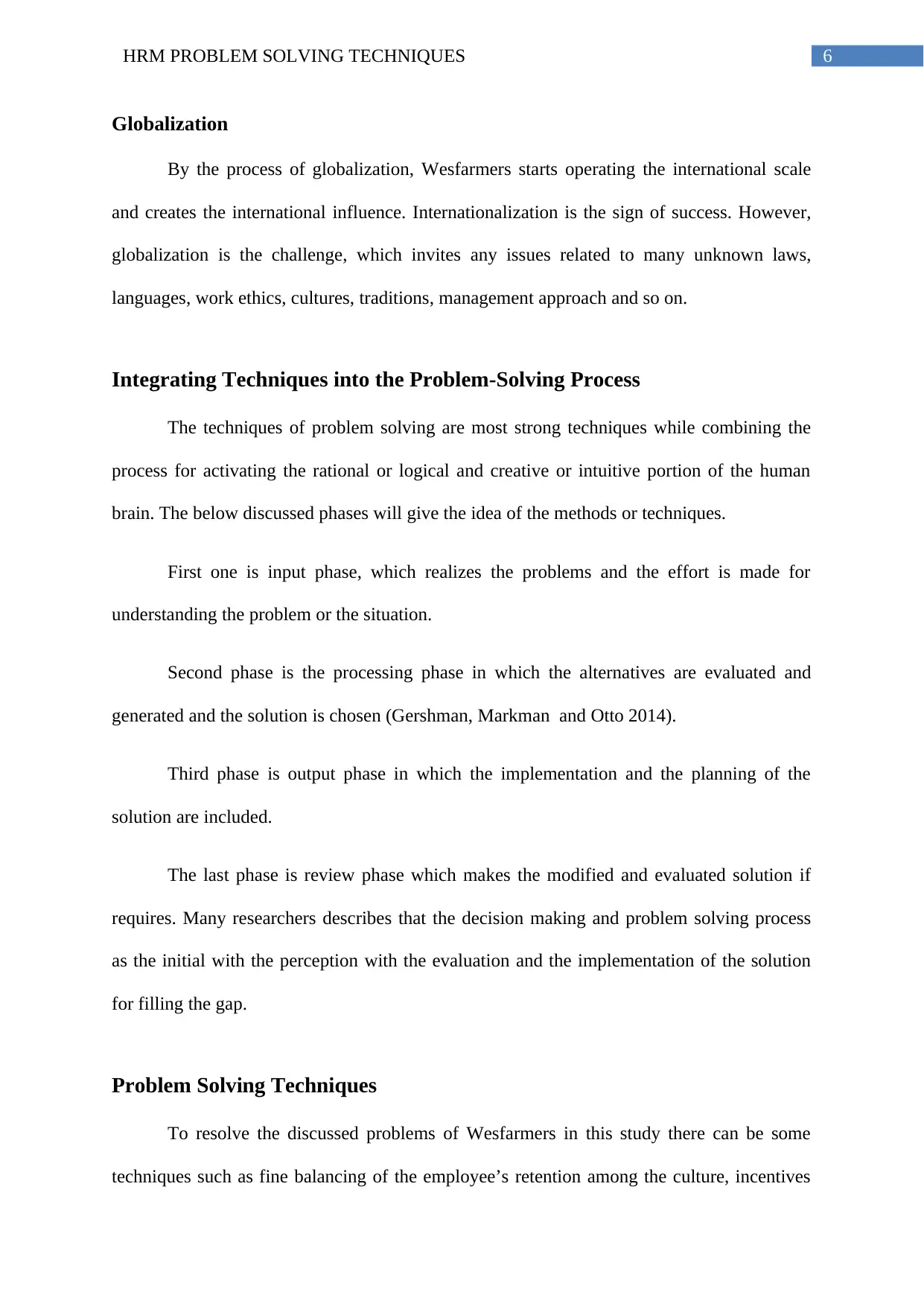
6HRM PROBLEM SOLVING TECHNIQUES
Globalization
By the process of globalization, Wesfarmers starts operating the international scale
and creates the international influence. Internationalization is the sign of success. However,
globalization is the challenge, which invites any issues related to many unknown laws,
languages, work ethics, cultures, traditions, management approach and so on.
Integrating Techniques into the Problem-Solving Process
The techniques of problem solving are most strong techniques while combining the
process for activating the rational or logical and creative or intuitive portion of the human
brain. The below discussed phases will give the idea of the methods or techniques.
First one is input phase, which realizes the problems and the effort is made for
understanding the problem or the situation.
Second phase is the processing phase in which the alternatives are evaluated and
generated and the solution is chosen (Gershman, Markman and Otto 2014).
Third phase is output phase in which the implementation and the planning of the
solution are included.
The last phase is review phase which makes the modified and evaluated solution if
requires. Many researchers describes that the decision making and problem solving process
as the initial with the perception with the evaluation and the implementation of the solution
for filling the gap.
Problem Solving Techniques
To resolve the discussed problems of Wesfarmers in this study there can be some
techniques such as fine balancing of the employee’s retention among the culture, incentives
Globalization
By the process of globalization, Wesfarmers starts operating the international scale
and creates the international influence. Internationalization is the sign of success. However,
globalization is the challenge, which invites any issues related to many unknown laws,
languages, work ethics, cultures, traditions, management approach and so on.
Integrating Techniques into the Problem-Solving Process
The techniques of problem solving are most strong techniques while combining the
process for activating the rational or logical and creative or intuitive portion of the human
brain. The below discussed phases will give the idea of the methods or techniques.
First one is input phase, which realizes the problems and the effort is made for
understanding the problem or the situation.
Second phase is the processing phase in which the alternatives are evaluated and
generated and the solution is chosen (Gershman, Markman and Otto 2014).
Third phase is output phase in which the implementation and the planning of the
solution are included.
The last phase is review phase which makes the modified and evaluated solution if
requires. Many researchers describes that the decision making and problem solving process
as the initial with the perception with the evaluation and the implementation of the solution
for filling the gap.
Problem Solving Techniques
To resolve the discussed problems of Wesfarmers in this study there can be some
techniques such as fine balancing of the employee’s retention among the culture, incentives
Paraphrase This Document
Need a fresh take? Get an instant paraphrase of this document with our AI Paraphraser
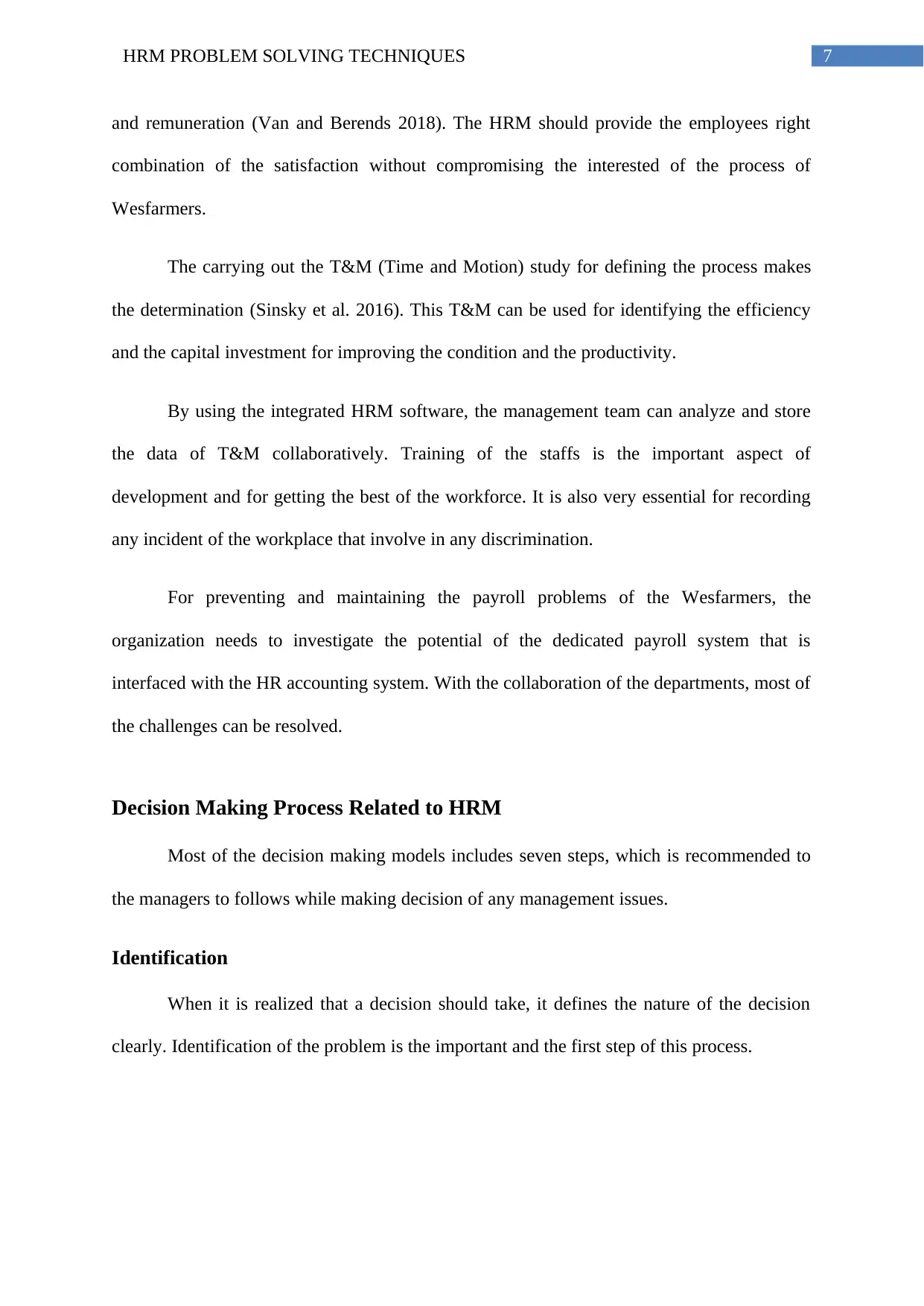
7HRM PROBLEM SOLVING TECHNIQUES
and remuneration (Van and Berends 2018). The HRM should provide the employees right
combination of the satisfaction without compromising the interested of the process of
Wesfarmers.
The carrying out the T&M (Time and Motion) study for defining the process makes
the determination (Sinsky et al. 2016). This T&M can be used for identifying the efficiency
and the capital investment for improving the condition and the productivity.
By using the integrated HRM software, the management team can analyze and store
the data of T&M collaboratively. Training of the staffs is the important aspect of
development and for getting the best of the workforce. It is also very essential for recording
any incident of the workplace that involve in any discrimination.
For preventing and maintaining the payroll problems of the Wesfarmers, the
organization needs to investigate the potential of the dedicated payroll system that is
interfaced with the HR accounting system. With the collaboration of the departments, most of
the challenges can be resolved.
Decision Making Process Related to HRM
Most of the decision making models includes seven steps, which is recommended to
the managers to follows while making decision of any management issues.
Identification
When it is realized that a decision should take, it defines the nature of the decision
clearly. Identification of the problem is the important and the first step of this process.
and remuneration (Van and Berends 2018). The HRM should provide the employees right
combination of the satisfaction without compromising the interested of the process of
Wesfarmers.
The carrying out the T&M (Time and Motion) study for defining the process makes
the determination (Sinsky et al. 2016). This T&M can be used for identifying the efficiency
and the capital investment for improving the condition and the productivity.
By using the integrated HRM software, the management team can analyze and store
the data of T&M collaboratively. Training of the staffs is the important aspect of
development and for getting the best of the workforce. It is also very essential for recording
any incident of the workplace that involve in any discrimination.
For preventing and maintaining the payroll problems of the Wesfarmers, the
organization needs to investigate the potential of the dedicated payroll system that is
interfaced with the HR accounting system. With the collaboration of the departments, most of
the challenges can be resolved.
Decision Making Process Related to HRM
Most of the decision making models includes seven steps, which is recommended to
the managers to follows while making decision of any management issues.
Identification
When it is realized that a decision should take, it defines the nature of the decision
clearly. Identification of the problem is the important and the first step of this process.
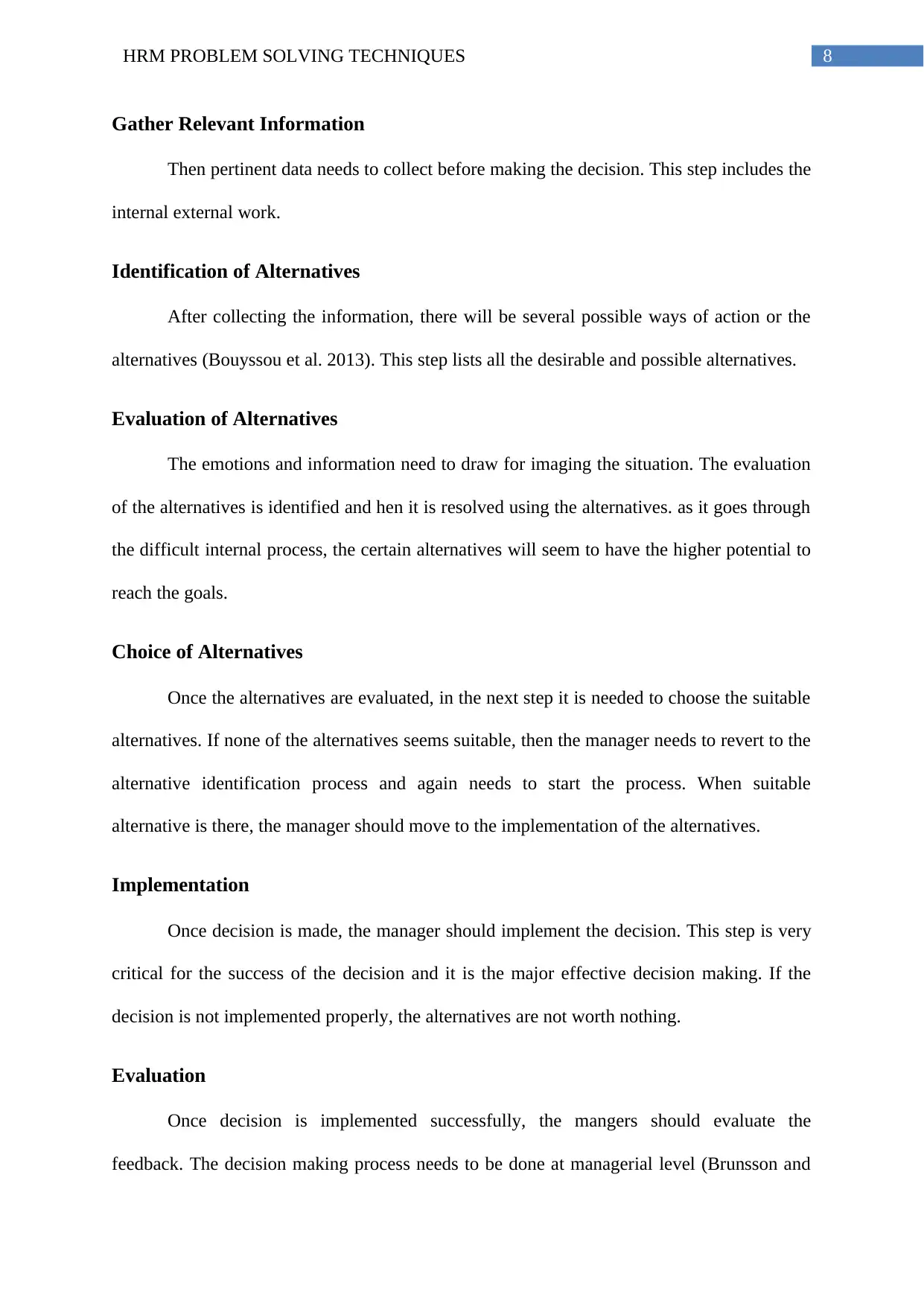
8HRM PROBLEM SOLVING TECHNIQUES
Gather Relevant Information
Then pertinent data needs to collect before making the decision. This step includes the
internal external work.
Identification of Alternatives
After collecting the information, there will be several possible ways of action or the
alternatives (Bouyssou et al. 2013). This step lists all the desirable and possible alternatives.
Evaluation of Alternatives
The emotions and information need to draw for imaging the situation. The evaluation
of the alternatives is identified and hen it is resolved using the alternatives. as it goes through
the difficult internal process, the certain alternatives will seem to have the higher potential to
reach the goals.
Choice of Alternatives
Once the alternatives are evaluated, in the next step it is needed to choose the suitable
alternatives. If none of the alternatives seems suitable, then the manager needs to revert to the
alternative identification process and again needs to start the process. When suitable
alternative is there, the manager should move to the implementation of the alternatives.
Implementation
Once decision is made, the manager should implement the decision. This step is very
critical for the success of the decision and it is the major effective decision making. If the
decision is not implemented properly, the alternatives are not worth nothing.
Evaluation
Once decision is implemented successfully, the mangers should evaluate the
feedback. The decision making process needs to be done at managerial level (Brunsson and
Gather Relevant Information
Then pertinent data needs to collect before making the decision. This step includes the
internal external work.
Identification of Alternatives
After collecting the information, there will be several possible ways of action or the
alternatives (Bouyssou et al. 2013). This step lists all the desirable and possible alternatives.
Evaluation of Alternatives
The emotions and information need to draw for imaging the situation. The evaluation
of the alternatives is identified and hen it is resolved using the alternatives. as it goes through
the difficult internal process, the certain alternatives will seem to have the higher potential to
reach the goals.
Choice of Alternatives
Once the alternatives are evaluated, in the next step it is needed to choose the suitable
alternatives. If none of the alternatives seems suitable, then the manager needs to revert to the
alternative identification process and again needs to start the process. When suitable
alternative is there, the manager should move to the implementation of the alternatives.
Implementation
Once decision is made, the manager should implement the decision. This step is very
critical for the success of the decision and it is the major effective decision making. If the
decision is not implemented properly, the alternatives are not worth nothing.
Evaluation
Once decision is implemented successfully, the mangers should evaluate the
feedback. The decision making process needs to be done at managerial level (Brunsson and
⊘ This is a preview!⊘
Do you want full access?
Subscribe today to unlock all pages.

Trusted by 1+ million students worldwide
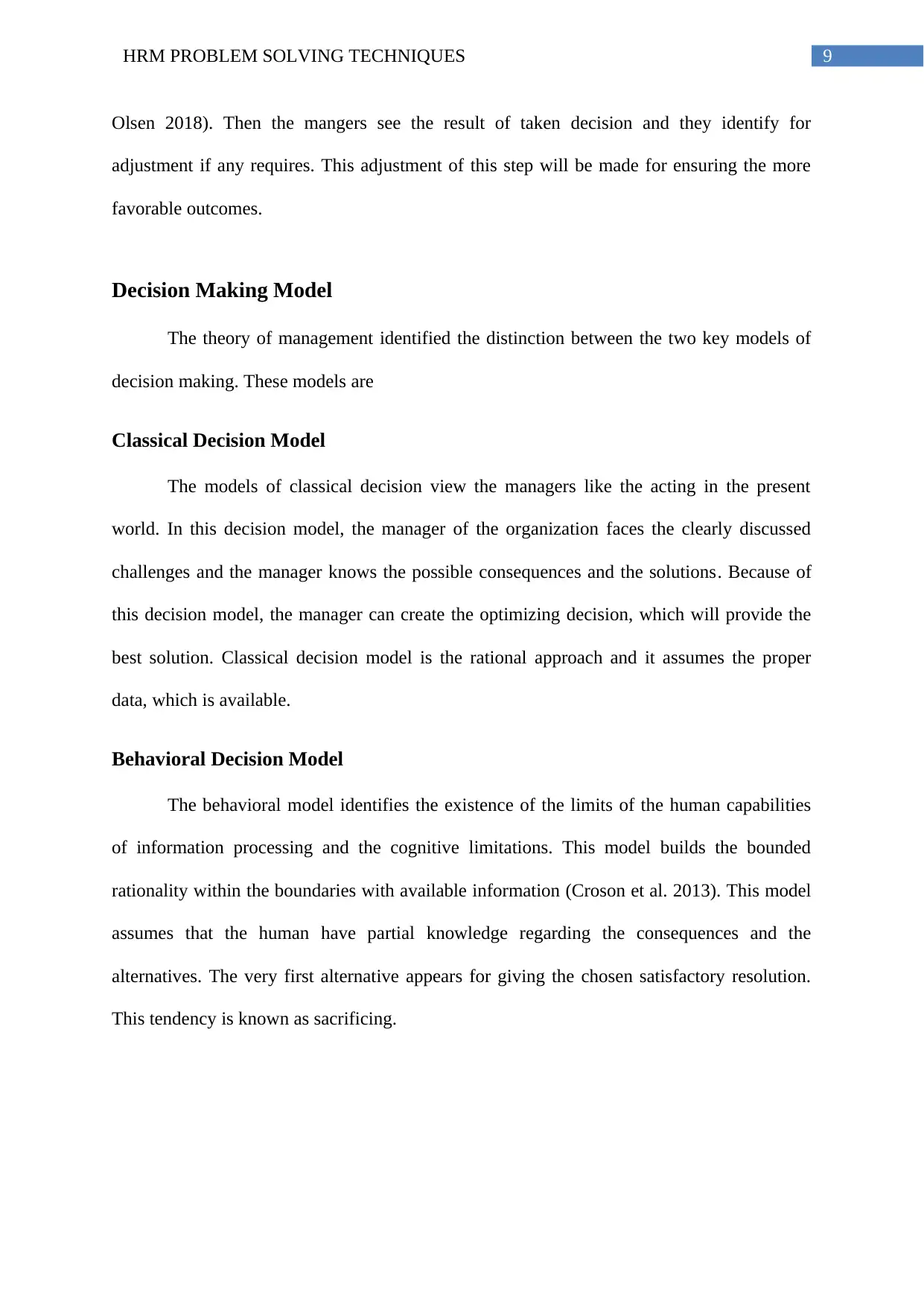
9HRM PROBLEM SOLVING TECHNIQUES
Olsen 2018). Then the mangers see the result of taken decision and they identify for
adjustment if any requires. This adjustment of this step will be made for ensuring the more
favorable outcomes.
Decision Making Model
The theory of management identified the distinction between the two key models of
decision making. These models are
Classical Decision Model
The models of classical decision view the managers like the acting in the present
world. In this decision model, the manager of the organization faces the clearly discussed
challenges and the manager knows the possible consequences and the solutions. Because of
this decision model, the manager can create the optimizing decision, which will provide the
best solution. Classical decision model is the rational approach and it assumes the proper
data, which is available.
Behavioral Decision Model
The behavioral model identifies the existence of the limits of the human capabilities
of information processing and the cognitive limitations. This model builds the bounded
rationality within the boundaries with available information (Croson et al. 2013). This model
assumes that the human have partial knowledge regarding the consequences and the
alternatives. The very first alternative appears for giving the chosen satisfactory resolution.
This tendency is known as sacrificing.
Olsen 2018). Then the mangers see the result of taken decision and they identify for
adjustment if any requires. This adjustment of this step will be made for ensuring the more
favorable outcomes.
Decision Making Model
The theory of management identified the distinction between the two key models of
decision making. These models are
Classical Decision Model
The models of classical decision view the managers like the acting in the present
world. In this decision model, the manager of the organization faces the clearly discussed
challenges and the manager knows the possible consequences and the solutions. Because of
this decision model, the manager can create the optimizing decision, which will provide the
best solution. Classical decision model is the rational approach and it assumes the proper
data, which is available.
Behavioral Decision Model
The behavioral model identifies the existence of the limits of the human capabilities
of information processing and the cognitive limitations. This model builds the bounded
rationality within the boundaries with available information (Croson et al. 2013). This model
assumes that the human have partial knowledge regarding the consequences and the
alternatives. The very first alternative appears for giving the chosen satisfactory resolution.
This tendency is known as sacrificing.
Paraphrase This Document
Need a fresh take? Get an instant paraphrase of this document with our AI Paraphraser
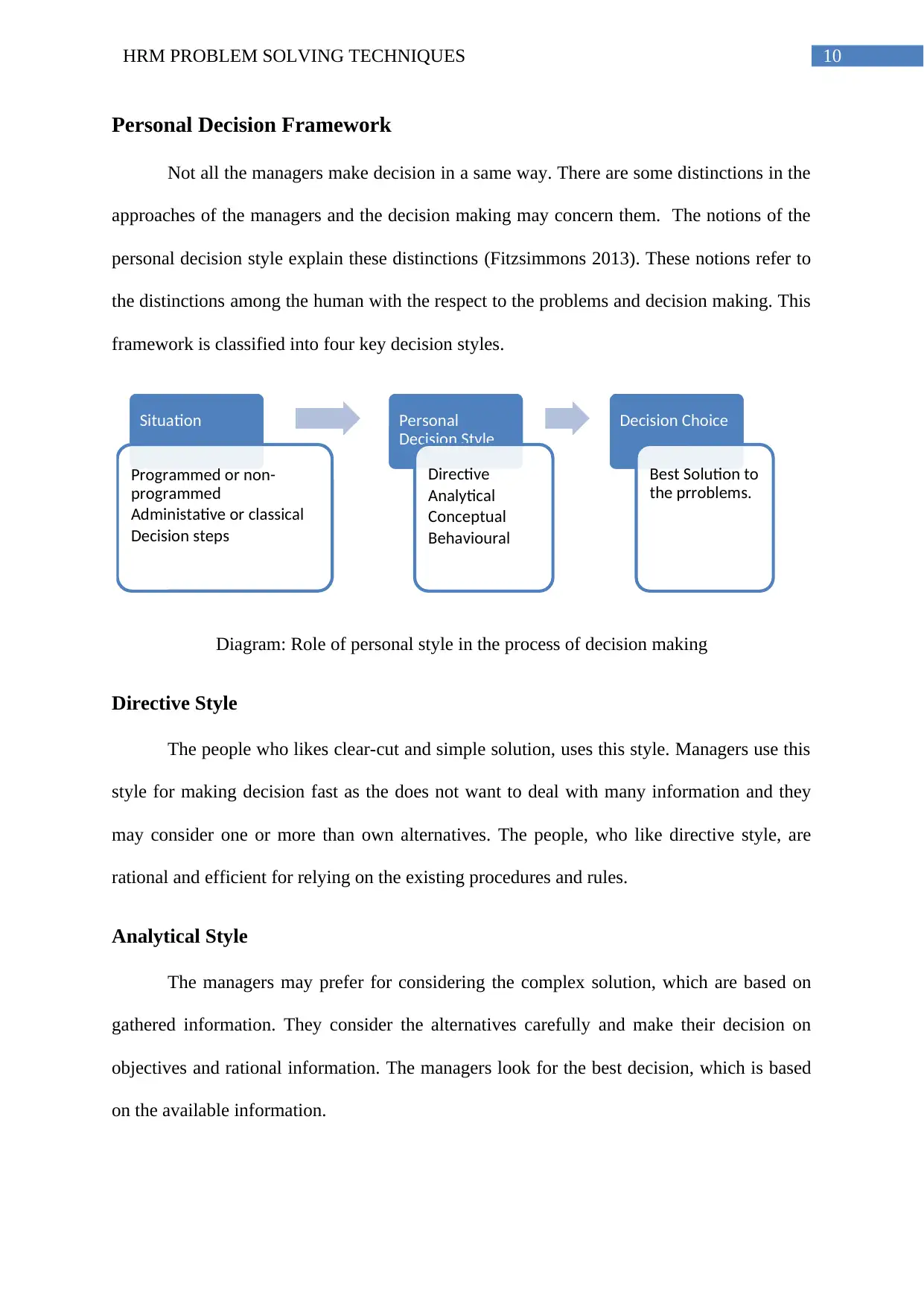
10HRM PROBLEM SOLVING TECHNIQUES
Personal Decision Framework
Not all the managers make decision in a same way. There are some distinctions in the
approaches of the managers and the decision making may concern them. The notions of the
personal decision style explain these distinctions (Fitzsimmons 2013). These notions refer to
the distinctions among the human with the respect to the problems and decision making. This
framework is classified into four key decision styles.
Diagram: Role of personal style in the process of decision making
Directive Style
The people who likes clear-cut and simple solution, uses this style. Managers use this
style for making decision fast as the does not want to deal with many information and they
may consider one or more than own alternatives. The people, who like directive style, are
rational and efficient for relying on the existing procedures and rules.
Analytical Style
The managers may prefer for considering the complex solution, which are based on
gathered information. They consider the alternatives carefully and make their decision on
objectives and rational information. The managers look for the best decision, which is based
on the available information.
Situation
Programmed or non-
programmed
Administative or classical
Decision steps
Personal
Decision Style
Directive
Analytical
Conceptual
Behavioural
Decision Choice
Best Solution to
the prroblems.
Personal Decision Framework
Not all the managers make decision in a same way. There are some distinctions in the
approaches of the managers and the decision making may concern them. The notions of the
personal decision style explain these distinctions (Fitzsimmons 2013). These notions refer to
the distinctions among the human with the respect to the problems and decision making. This
framework is classified into four key decision styles.
Diagram: Role of personal style in the process of decision making
Directive Style
The people who likes clear-cut and simple solution, uses this style. Managers use this
style for making decision fast as the does not want to deal with many information and they
may consider one or more than own alternatives. The people, who like directive style, are
rational and efficient for relying on the existing procedures and rules.
Analytical Style
The managers may prefer for considering the complex solution, which are based on
gathered information. They consider the alternatives carefully and make their decision on
objectives and rational information. The managers look for the best decision, which is based
on the available information.
Situation
Programmed or non-
programmed
Administative or classical
Decision steps
Personal
Decision Style
Directive
Analytical
Conceptual
Behavioural
Decision Choice
Best Solution to
the prroblems.
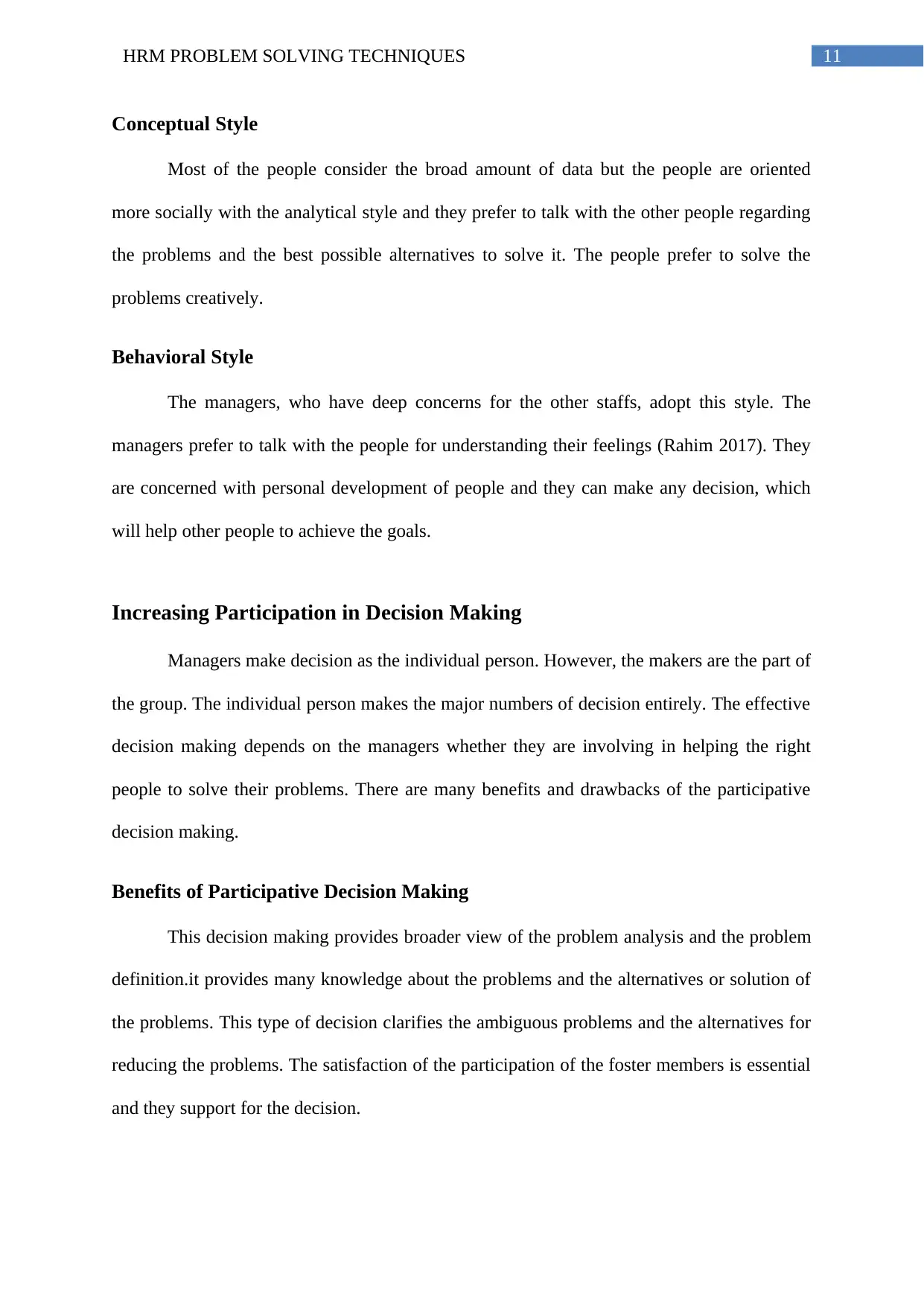
11HRM PROBLEM SOLVING TECHNIQUES
Conceptual Style
Most of the people consider the broad amount of data but the people are oriented
more socially with the analytical style and they prefer to talk with the other people regarding
the problems and the best possible alternatives to solve it. The people prefer to solve the
problems creatively.
Behavioral Style
The managers, who have deep concerns for the other staffs, adopt this style. The
managers prefer to talk with the people for understanding their feelings (Rahim 2017). They
are concerned with personal development of people and they can make any decision, which
will help other people to achieve the goals.
Increasing Participation in Decision Making
Managers make decision as the individual person. However, the makers are the part of
the group. The individual person makes the major numbers of decision entirely. The effective
decision making depends on the managers whether they are involving in helping the right
people to solve their problems. There are many benefits and drawbacks of the participative
decision making.
Benefits of Participative Decision Making
This decision making provides broader view of the problem analysis and the problem
definition.it provides many knowledge about the problems and the alternatives or solution of
the problems. This type of decision clarifies the ambiguous problems and the alternatives for
reducing the problems. The satisfaction of the participation of the foster members is essential
and they support for the decision.
Conceptual Style
Most of the people consider the broad amount of data but the people are oriented
more socially with the analytical style and they prefer to talk with the other people regarding
the problems and the best possible alternatives to solve it. The people prefer to solve the
problems creatively.
Behavioral Style
The managers, who have deep concerns for the other staffs, adopt this style. The
managers prefer to talk with the people for understanding their feelings (Rahim 2017). They
are concerned with personal development of people and they can make any decision, which
will help other people to achieve the goals.
Increasing Participation in Decision Making
Managers make decision as the individual person. However, the makers are the part of
the group. The individual person makes the major numbers of decision entirely. The effective
decision making depends on the managers whether they are involving in helping the right
people to solve their problems. There are many benefits and drawbacks of the participative
decision making.
Benefits of Participative Decision Making
This decision making provides broader view of the problem analysis and the problem
definition.it provides many knowledge about the problems and the alternatives or solution of
the problems. This type of decision clarifies the ambiguous problems and the alternatives for
reducing the problems. The satisfaction of the participation of the foster members is essential
and they support for the decision.
⊘ This is a preview!⊘
Do you want full access?
Subscribe today to unlock all pages.

Trusted by 1+ million students worldwide
1 out of 26
Related Documents
Your All-in-One AI-Powered Toolkit for Academic Success.
+13062052269
info@desklib.com
Available 24*7 on WhatsApp / Email
![[object Object]](/_next/static/media/star-bottom.7253800d.svg)
Unlock your academic potential
Copyright © 2020–2025 A2Z Services. All Rights Reserved. Developed and managed by ZUCOL.




